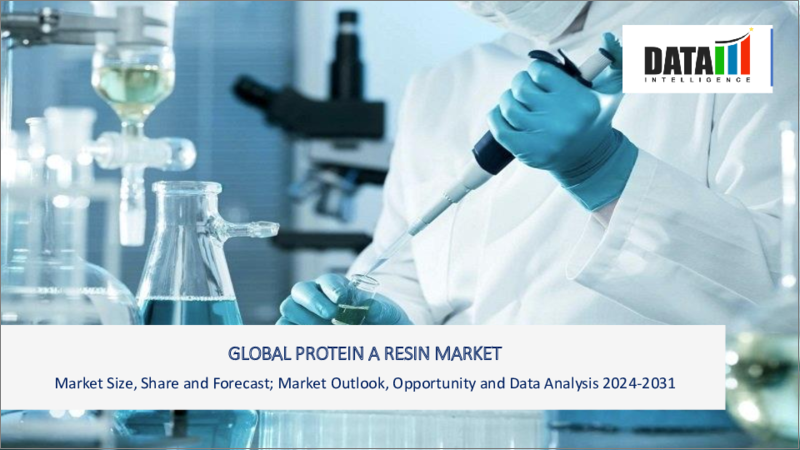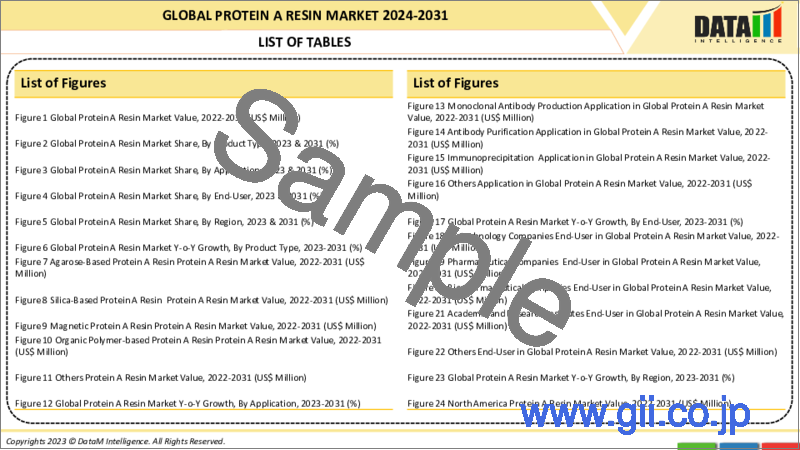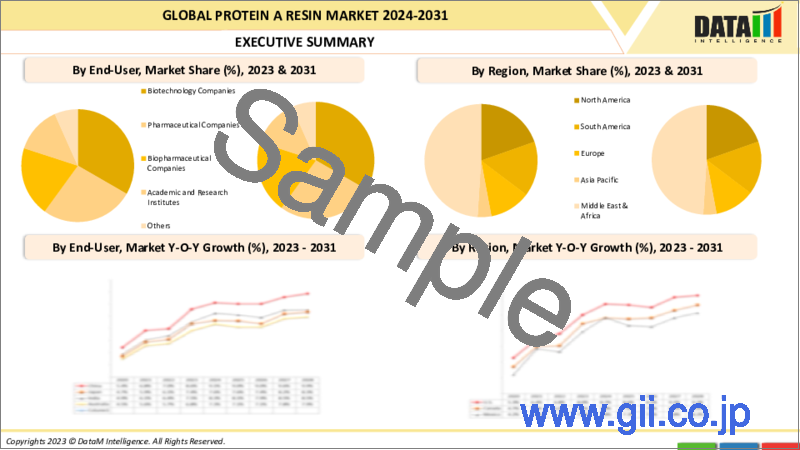|
|
市場調査レポート
商品コード
1374855
プロテインA樹脂の世界市場-2023年~2030年Global Protein A Resin Market - 2023-2030 |
||||||
カスタマイズ可能
適宜更新あり
|
|||||||
| プロテインA樹脂の世界市場-2023年~2030年 |
|
出版日: 2023年11月01日
発行: DataM Intelligence
ページ情報: 英文 187 Pages
納期: 即日から翌営業日
|
- 全表示
- 概要
- 目次
概要
プロテインA樹脂はバイオ製薬・バイオテクノロジー工程で特に使われているクロマトグラフィー用媒質で、抗体(特にモノクローナル抗体(mAb))の精製に主に使用されます。この樹脂は、バイオ製造における下流工程の重要な構成要素です。この樹脂はプロテインAで固定化されており、細胞培養上清やバイオプロセス液のような混合物から抗体を捕捉することができます。
さらに、精製プロセスでは、プロテインA樹脂を充填したカラムに混合物をロードし、そこで抗体を樹脂に結合させます。樹脂に結合した抗体は溶出され、高純度の抗体を得るために処理されます。この技術は、治療用抗体を製造し、バイオ医薬品の安全性と有効性を確保するために極めて重要です。
市場力学:促進要因
抗体需要の増加
抗体に対する需要の増加は、予測期間を通じて市場を牽引すると予想されます。抗体によってもたらされる利点は、単一の疾患だけに限定されるものではなく、主に様々な種類のがん、自己免疫疾患、感染症を含む幅広い疾患の治療に用いられています。そのため、多くの研究センターや市場関係者がプロテインA樹脂市場の成長に注目しています。
例えば、2023年9月14日、リムリック大学のアイルランド科学財団(SFI)医薬品研究センター(SPC)は、プロテインA樹脂市場の成長に対応するため、主要産業パートナーとの提携の第2段階を開始しました。この共同プロジェクトでは、最先端の研究機器を駆使して、樹脂の再利用の可能性と実現可能性を探り、抗体医薬の製造をよりコスト効率よく、環境にやさしいものにします。
さらに、mAbは特に疾患経路に関与する特定の分子を標的とするように設計されており、様々な重篤な疾患の治療に高い効果を発揮します。この特異性により副作用が最小限に抑えられ、mAbは多くの病状に適した選択肢となっています。多くの主要企業が、mAbの精製と製造のためにプロテインA樹脂に注目しています。
例えば、2020年3月18日、ライフサイエンス、先端技術、応用材料業界の顧客にミッションクリティカルな製品とサービスを提供する世界の大手プロバイダーであるAvantor, Inc.は、mAb製造時に抗体を精製するために使用される新しい組換えプロテインAアフィニティークロマトグラフィー樹脂を発売しました。プロテインAクロマトグラフィーは、mAb製造における下流の精製工程として実績があります。しかし、純度と収率を向上させながら、精製コストを削減する必要があります。新しいAvantorリコンビナント・プロテインA樹脂は、これらの課題を解決することが知られています。
さらに、がんや慢性疾患の有病率の増加、プロテインA樹脂に対するFDA承認の増加、プロテインA樹脂による抗体の精製に関する臨床試験の増加、プロテインA樹脂の利点に関する認知度の増加、プロテインAクロマトグラフィー樹脂の開発における進歩は、予測期間中に市場を牽引すると予想される要因です。
阻害要因
プロテインA樹脂に関連する合併症、プロテインAの溶出と毒性、低pH溶出、プロテインA樹脂に関連する高コストなどの要因が市場を阻害すると予想される要因です。
目次
第1章 調査手法と調査範囲
第2章 定義と概要
第3章 エグゼクティブサマリー
第4章 市場力学
- 影響要因
- 促進要因
- 抗体需要の増加
- 抑制要因
- 低pH溶出
- 機会
- 影響分析
- 促進要因
第5章 産業分析
- ポーターのファイブフォース分析
- サプライチェーン分析
- 価格分析
- 規制分析
- パイプライン分析
- アンメットニーズ
- DMIの見解
第6章 COVID-19分析
第7章 製品タイプ別
- アガロースベースのプロテインA樹脂
- シリカベースプロテインA樹脂
- 磁性プロテインA樹脂
- 有機ポリマーベースのプロテインA樹脂
- その他
第8章 用途別
- モノクローナル抗体作製
- 抗体精製
- 免疫沈降
- その他
第9章 エンドユーザー別
- バイオテクノロジー企業
- 製薬企業
- バイオ医薬品企業
- 学術・研究機関
- その他
第10章 地域別
- 北米
- 米国
- カナダ
- メキシコ
- 欧州
- ドイツ
- 英国
- フランス
- イタリア
- スペイン
- その他欧州
- 南米
- ブラジル
- アルゼンチン
- その他南米
- アジア太平洋
- 中国
- インド
- 日本
- オーストラリア
- その他アジア太平洋
- 中東・アフリカ
第11章 競合情勢
- 競合シナリオ
- 市況/シェア分析
- M&A分析
第12章 企業プロファイル
- GE Healthcare
- 会社概要
- 製品ポートフォリオと説明
- 財務概要
- 主な動向
- Bio-Rad Laboratories, Inc.
- Merck KGaA
- Thermo Fisher Scientific Inc.
- Tosoh Bioscience LLC
- Cytiva
- IPSUM LIFESCIENCES LLP
- Repligen Corporation
- Purolite Corporation
- Avantor Inc.
第13章 付録
Overview
Protein A resin is a chromatography medium that is especially used in biopharmaceutical and biotechnology processes mainly for the purification of antibodies, particularly monoclonal antibodies (mAbs). This resin is a key component of downstream processing in biomanufacturing. The resin is immobilized with protein A, allowing it to capture antibodies from a mixture like cell culture supernatant or bioprocess fluid.
Moreover, the purification process involves loading the mixture onto a column packed with protein A resin, where the antibodies bind to the resin. The resin-bound antibodies are eluted and processed to obtain highly pure antibodies. This technology is crucial for producing therapeutic antibodies and ensuring the safety and efficacy of biopharmaceutical products.
Market Dynamics: Drivers
Increasing demand for antibodies
The increasing demand for antibodies is expected to drive the market over the forecast period. The advantages offered by antibodies are not only limited to a single disease, mainly they are employed in the treatment of a wide range of illnesses including various types of cancers, autoimmune disorders and infectious diseases. Thus many research centers and market players are focusing on the growth of the protein A resin market.
For instance, on September 14, 2023, SPC, the Science Foundation Ireland (SFI) Research Centre for Pharmaceuticals, at the University of Limerick launched phase two of a partnership with leading industry partners to address the growth in the protein A resin market. This collaborative project is using state of the art research instrumentation to explore the possibility and feasibility of reusing resins, making the production of antibody medicines, more cost-effective and environmentally friendly.
Moreover, mAbs especially designed to target the specific molecules involved in disease pathways, by making them highly effective in treating various serious diseases. This specificity minimizes the side effects associated with them and making mAbs a preferred choice for many medical conditions. Even, many key players are focussing on protein A resins for the purification and manufacturing of mAbs.
For instance, on March 18, 2020, Avantor, Inc., a leading global provider of mission-critical products and services to customers in the life sciences, advanced technologies and applied materials industries, launched a new recombinant Protein A affinity chromatography resin used to purify antibodies during mAbs production. Protein A chromatography is a proven downstream purification step in manufacturing mAbs. Yet, there remains a need to reduce the total purification costs while improving purity and yield. The new Avantor recombinant protein A resin is known to address these challenges.
Further, the increasing prevalence of cancers and chronic diseases, rising FDA approvals for the protein A resins, increasing clinical trials for the purification of antibodies by protein A resins, increasing awareness about the advantages of the protein A resins and advancements in the development of protein A chromatography resins are the factors expected to drive the market over the forecast period.
Restraints
Factors such as complications associated with the protein A resins, protein A leaching and toxicity, low pH elution and the high cost associated with protein A resins are the factors expected to hamper the market.
Segment Analysis
The global protein A resin market is segmented based on product type, application, end-user and region.
The agarose-based protein A resins segment accounted for approximately 43.2% of the protein A resin market share
The agarose-based protein A resins segment is expected to hold the largest market share over the forecast period. Agarose-based protein A resins are widely utilized in biopharmaceutical and biotechnology industries for the purification of monoclonal antibodies (mAbs) due to their high binding capacity and ability to efficiently capture and purify a large number of antibodies. They are also designed to address the purification of pH-sensitive antibodies.
For instance, on September 30, 2021, Purolite launched the novel next-generation chromatography resins, Praesto Jetted A50 HipH and Praesto Jetted (dT)18-DVB. Praesto Jetted A50 HipH is the world's first protein A alkaline stable resin based on a 50μm uniform agarose bead, designed to address the purification of pH-sensitive antibodies or other Fc-containing proteins. With 40 years of resin bead expertise, Purolite has combined 'Jetting' technology, an innovative process that produces uniform-size agarose beads with a very narrow particle size distribution together with a new, Protein A ligand, NGL-Impact A Hi pH, from Repligen Corporation.
Furthermore, agarose resins have excellent flow properties, that are essential for efficient chromatographic separation. Good flow properties allow for faster processing and better resolution. Agarose resins are chemically stable under a wide range of pH and salt conditions commonly used in protein purification processes. Agarose-based resins are compatible with various chromatography techniques including affinity chromatography, which is most commonly used for antibody purification.
Geographical Analysis
North America accounted for approximately 40.2% of the market share
North America region is expected to hold the largest market share over the forecast period owing to the strong presence of major players and increasing adoption of protein A resins. North America especially the United States is known for its strong presence of major players such as biopharmaceutical and biotechnology companies. These companies are actively involved in the research, development and production of therapeutic monoclonal antibodies (mAbs) and other biologics by using protein A resins.
For instance, on January 27, 2021, Cytiva launched HiScreen Fibro PrismA, the newest product available for early monoclonal antibody (mAb) purification process development. The product complements HiTrap Fibro PrismA, the company's new fiber-based Protein A platform launched for research applications. The Fibro technology features an open porous adsorbent material comprising cellulose fibers designed for rapid mass transfer. Fibro PrismA uses the same chromatography systems, infrastructure and ligands as resin chromatography, which allows for a simple transition into existing biomanufacturing facilities.
Furthermore, increasing adoption of protein A resins in various biotechnology and biopharmaceutical industries is also expected to drive the market in the region. The demand for biologic therapies including antibodies and mAbs has been steadily increasing in the region, this further increases the adoption of the protein A resins for its purification.
Competitive Landscape
The major global players in the protein A resin market include: GE Healthcare, Bio-Rad Laboratories, Inc., Merck KGaA, Thermo Fisher Scientific Inc., Tosoh Bioscience LLC, Cytiva, IPSUM LIFESCIENCES LLP, Repligen Corporation, Purolite Corporation and Avantor Inc among others.
COVID-19 Impact Analysis
The COVID-19 pandemic significantly impacted the global protein A resin market. During the pandemic, there is an increased demand for therapeutic antibodies and diagnostic tests for COVID-19. This resulted in an increased adoption and need for the purification of antibodies, where protein A resins play a crucial role. As a result, some manufacturers of protein A resins experienced increased demand for their products.
For instance, on February 08, 2021, Repligen Corporation, a life sciences company focused on bioprocessing technology leadership and Navigo Proteins GmbH, a premier protein engineering company specializing in novel affinity ligand development, released that they had completed the development and initiated the commercial launch of NGL COVID-19 Spike Protein Affinity Resin, a novel affinity resin to be utilized in the purification of COVID-19 vaccines.
Market Segmentation
By Product Type
- Agarose-Based Protein A Resins
- Silica-Based Protein A Resins
- Magnetic Protein A Resins
- Organic Polymer-based Protein A Resins
- Others
By Application
- Monoclonal Antibody Production
- Antibody Purification
- Immunoprecipitation
- Others
By End-User
- Biotechnology Companies
- Pharmaceutical Companies
- Biopharmaceutical Companies
- Academic and Research Institutes
- Others
By Region
- North America
- U.S.
- Canada
- Mexico
- Europe
- Germany
- U.K.
- France
- Spain
- Italy
- Rest of Europe
- South America
- Brazil
- Argentina
- Rest of South America
- Asia-Pacific
- China
- India
- Japan
- Australia
- Rest of Asia-Pacific
- Middle East and Africa
Why Purchase the Report?
- To visualize the global protein A resin market segmentation based on product type, application, end-user and region as well as understand key commercial assets and players.
- Identify commercial opportunities by analyzing trends and co-development
- Excel data sheet with numerous data points of protein A resin market-level with all segments.
- PDF report consists of a comprehensive analysis after exhaustive qualitative interviews and an in-depth study.
- Product mapping available as excel consisting of key products of all the major players.
The global protein A resin market report would provide approximately 61 tables, 62 figures, and 187 Pages.
Target Audience 2023
- Manufacturers/ Buyers
- Industry Investors/Investment Bankers
- Research Professionals
- Emerging Companies
Table of Contents
1. Methodology and Scope
- 1.1. Research Methodology
- 1.2. Research Objective and Scope of the Report
2. Definition and Overview
3. Executive Summary
- 3.1. Snippet by Product Type
- 3.2. Snippet by Application
- 3.3. Snippet by End-User
- 3.4. Snippet by Region
4. Dynamics
- 4.1. Impacting Factors
- 4.1.1. Drivers
- 4.1.1.1. Increasing Demand for Antibodies
- 4.1.2. Restraints
- 4.1.2.1. Low pH Elution
- 4.1.3. Opportunity
- 4.1.4. Impact Analysis
- 4.1.1. Drivers
5. Industry Analysis
- 5.1. Porter's Five Force Analysis
- 5.2. Supply Chain Analysis
- 5.3. Pricing Analysis
- 5.4. Regulatory Analysis
- 5.5. Pipeline Analysis
- 5.6. Unmet Needs
- 5.7. DMI Opinion
6. COVID-19 Analysis
- 6.1. Analysis of COVID-19
- 6.1.1. Scenario Before COVID
- 6.1.2. Scenario During COVID
- 6.1.3. Scenario Post COVID
- 6.2. Pricing Dynamics Amid COVID-19
- 6.3. Demand-Supply Spectrum
- 6.4. Government Initiatives Related to the Market During the Pandemic
- 6.5. Manufacturers Strategic Initiatives
- 6.6. Conclusion
7. By Product Type
- 7.1. Introduction
- 7.1.1. Market Size Analysis and Y-o-Y Growth Analysis (%), By Product Type
- 7.1.2. Market Attractiveness Index, By Product Type
- 7.2. Agarose-Based Protein A Resin*
- 7.2.1. Introduction
- 7.2.2. Market Size Analysis and Y-o-Y Growth Analysis (%)
- 7.3. Silica-Based Protein A Resin
- 7.4. Magnetic Protein A Resin
- 7.5. Organic Polymer-based Protein A Resin
- 7.6. Others
8. By Application
- 8.1. Introduction
- 8.1.1. Market Size Analysis and Y-o-Y Growth Analysis (%), By Application
- 8.1.2. Market Attractiveness Index, By Application
- 8.2. Monoclonal Antibody Production*
- 8.2.1. Introduction
- 8.2.2. Market Size Analysis and Y-o-Y Growth Analysis (%)
- 8.3. Antibody Purification
- 8.4. Immunoprecipitation
- 8.5. Others
9. By End-User
- 9.1. Introduction
- 9.1.1. Market Size Analysis and Y-o-Y Growth Analysis (%), By End-User
- 9.1.2. Market Attractiveness Index, By End-User
- 9.2. Biotechnology Companies*
- 9.2.1. Introduction
- 9.2.2. Market Size Analysis and Y-o-Y Growth Analysis (%)
- 9.3. Pharmaceutical Companies
- 9.4. Biopharmaceutical Companies
- 9.5. Academic and Research Institutes
- 9.6. Others
10. By Region
- 10.1. Introduction
- 10.1.1. Market Size Analysis and Y-o-Y Growth Analysis (%), By Region
- 10.1.2. Market Attractiveness Index, By Region
- 10.2. North America
- 10.2.1. Introduction
- 10.2.2. Key Region-Specific Dynamics
- 10.2.3. Market Size Analysis and Y-o-Y Growth Analysis (%), By Product Type
- 10.2.4. Market Size Analysis and Y-o-Y Growth Analysis (%), By Application
- 10.2.5. Market Size Analysis and Y-o-Y Growth Analysis (%), By End-User
- 10.2.6. Market Size Analysis and Y-o-Y Growth Analysis (%), By Country
- 10.2.6.1. U.S.
- 10.2.6.2. Canada
- 10.2.6.3. Mexico
- 10.3. Europe
- 10.3.1. Introduction
- 10.3.2. Key Region-Specific Dynamics
- 10.3.3. Market Size Analysis and Y-o-Y Growth Analysis (%), By Product Type
- 10.3.4. Market Size Analysis and Y-o-Y Growth Analysis (%), By Application
- 10.3.5. Market Size Analysis and Y-o-Y Growth Analysis (%), By End-User
- 10.3.6. Market Size Analysis and Y-o-Y Growth Analysis (%), By Country
- 10.3.6.1. Germany
- 10.3.6.2. UK
- 10.3.6.3. France
- 10.3.6.4. Italy
- 10.3.6.5. Spain
- 10.3.6.6. Rest of Europe
- 10.4. South America
- 10.4.1. Introduction
- 10.4.2. Key Region-Specific Dynamics
- 10.4.3. Market Size Analysis and Y-o-Y Growth Analysis (%), By Product Type
- 10.4.4. Market Size Analysis and Y-o-Y Growth Analysis (%), By Application
- 10.4.5. Market Size Analysis and Y-o-Y Growth Analysis (%), By End-User
- 10.4.6. Market Size Analysis and Y-o-Y Growth Analysis (%), By Country
- 10.4.6.1. Brazil
- 10.4.6.2. Argentina
- 10.4.6.3. Rest of South America
- 10.5. Asia-Pacific
- 10.5.1. Introduction
- 10.5.2. Key Region-Specific Dynamics
- 10.5.3. Market Size Analysis and Y-o-Y Growth Analysis (%), By Product Type
- 10.5.4. Market Size Analysis and Y-o-Y Growth Analysis (%), By Application
- 10.5.5. Market Size Analysis and Y-o-Y Growth Analysis (%), By End-User
- 10.5.6. Market Size Analysis and Y-o-Y Growth Analysis (%), By Country
- 10.5.6.1. China
- 10.5.6.2. India
- 10.5.6.3. Japan
- 10.5.6.4. Australia
- 10.5.6.5. Rest of Asia-Pacific
- 10.6. Middle East and Africa
- 10.6.1. Introduction
- 10.6.2. Key Region-Specific Dynamics
- 10.6.3. Market Size Analysis and Y-o-Y Growth Analysis (%), By Product Type
- 10.6.4. Market Size Analysis and Y-o-Y Growth Analysis (%), By Application
- 10.6.5. Market Size Analysis and Y-o-Y Growth Analysis (%), By End-User
11. Competitive Landscape
- 11.1. Competitive Scenario
- 11.2. Market Positioning/Share Analysis
- 11.3. Mergers and Acquisitions Analysis
12. Company Profiles
- 12.1. GE Healthcare*
- 12.1.1. Company Overview
- 12.1.2. Product Portfolio and Description
- 12.1.3. Financial Overview
- 12.1.4. Key Developments
- 12.2. Bio-Rad Laboratories, Inc.
- 12.3. Merck KGaA
- 12.4. Thermo Fisher Scientific Inc.
- 12.5. Tosoh Bioscience LLC
- 12.6. Cytiva
- 12.7. IPSUM LIFESCIENCES LLP
- 12.8. Repligen Corporation
- 12.9. Purolite Corporation
- 12.10. Avantor Inc.
LIST NOT EXHAUSTIVE
13. Appendix
- 13.1. About Us and Services
- 13.2. Contact Us






